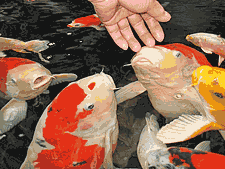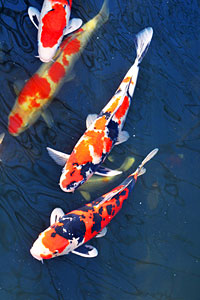Koi Pond Feeding – Add Bugs!
 If your backyard garden ecosystem includes a pond, it is very natural that you also have fish in that pond. In order to keep the pond in healthy balance, you need to maintain the correct number of fish for the pond’s size, feed them properly, and monitor the water.
If your backyard garden ecosystem includes a pond, it is very natural that you also have fish in that pond. In order to keep the pond in healthy balance, you need to maintain the correct number of fish for the pond’s size, feed them properly, and monitor the water.

Managing a school of koi or goldfish is not just about how many fish you have, but about how many pounds of fish you have. Stocking too many fish in your pond leads to both a decreased oxygen supply and to ammonia and nitrate build-up from additional fish waste.
Smart Koi Feeding
Feed your koi the right foods in the correct amounts and you are all set. It sounds easy, but there’s quite a science to mastering it.
Generally, advice is to be sure to feed your fish only what they can eat in five minutes. Also, be aware that at water temperatures above 65 degrees, your fish need more food and higher protein food. When water temperatures are above 90 degrees you should stop feeding your fish. If the temperature drops below 60 degrees, you should reduce feeding, and use a lower protein food. When the water temperature is lower than fifty degrees, you should stop feeding them.
How Do Bo-Jo Lights Fit In?

During nearly the whole cycle of temperatures in your pond, your fish will eat internal pond nutrients in addition to fish food. When the metabolism of your fish is highest (65-85 degree water temperatures), they can really use any additional high-protein food source.
Alternatively, when you reduce your feeding schedule at water temperatures below 60 degrees, you will find the fish actively “begging” for food on days when the surface of your pond is warmed up a bit. In addition to the pond algae that they subsist on during cooler months, the use of a Bo-Jo light will be welcomed by them.